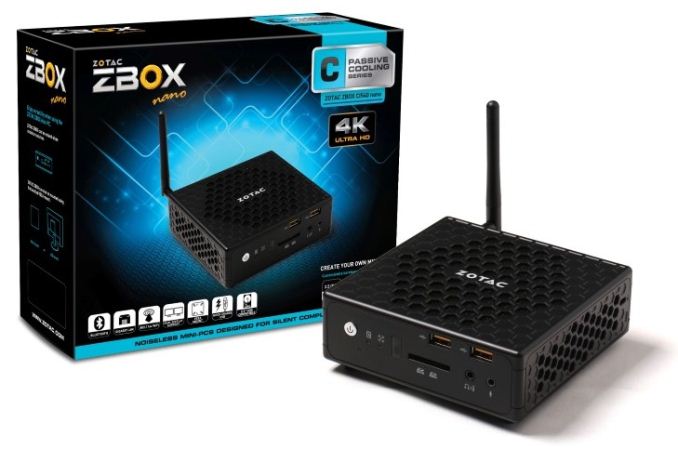Zotac ZBOX CI540 nano Review: A Fanless Haswell-Y mini-PC
by Ganesh T S on October 31, 2014 11:00 AM ESTFinal Words
Zotac's ZBOX CI540 nano provided us with the first opportunity to evaluate the performance of a Y-series CPU from Intel. The Core i5-4210Y is surprisingly powerful. Passively cooled systems are either very costly (particularly if they integrate powerful CPUs) or downright abysmal in performance (when they integrate the low-end / low-power CPUs such as the older Atoms). Zotac's offering with the ZBOX CI540 nano aims to strike a balance. $335 for a barebones configuration is quite reasonable for this type of system.
One of the aspects that we were worried about prior to evaluation was thermal throttling. Fortunately for Zotac, the Core i5-4210Y seems to keep the scenario design power (SDP) in mind while managing the internal clocks. Intel's intent with the Y-series is such that CPU performance needs to be talked about in terms of power consumption rather than absolute clocks. Outside the benchmarking circus, day-to-day workloads for the average mini-PC user actually fall rather nicely into the SDP aspect.
Pretty much the only downside of the unit is the unreasonably high idle power. Perhaps Zotac could look into some default BIOS optimizations to resolve that aspect. Other than that, the platform ticks everything needed in the mini-PC market - plenty of USB ports, quick charging capabilities, 802.11ac WLAN with Bluetooth integrated, a SD card reader and even a Display Port output along with the traditional HDMI. All these are packaged along with the Core i5-4210Y - one of the most powerful CPUs in the 11.5W TDP range. With the ZBOX CI540 nano, Zotac has managed to deliver the right balance of price and performance in the fanless mini-PC market.











48 Comments
View All Comments
p@nc@k3s - Friday, October 31, 2014 - link
To me, it really is the footprint and fanless design that would make me buy this over a notebook.james16 - Monday, November 3, 2014 - link
Same for me. From my own anecdotal experience and expecting to use a PC for 6+ years, fans can suck in a lot of dust over time. The dust can cause overheating and throttling issues. Sometimes, the fans fail at some point too. I'm done with opening up PCs to clean/replace things. It's just not worth my time anymore. Also, notebooks are even more time consuming to open up to clean/replace stuff.So far with my experience with fanless devices is that they don't attract as much dust and, of course, no fans that can fail. However, you have to choose the right device. I've encountered some devices where the thermal design wasn't very good and you get throttling under normal conditions.
Aikouka - Friday, October 31, 2014 - link
Sure. Pretty much anything can be a HTPC as long as it meets your media needs. Some people just have different needs. For example, you probably cannot VESA mount a laptop on the back of a monitor/TV, but you can do that with a NUC/UCFF PC (I do that with my touch-based HTPC).Spectrophobic - Friday, October 31, 2014 - link
Pretty sure it isn't that hard to DIY a mount for a laptop behind a monitor/TV.gopher1369 - Friday, October 31, 2014 - link
In a corporate environment installing 500 of them at once?barleyguy - Saturday, November 1, 2014 - link
In a corporate environment the solution would be to check the laptops out to employees and buy docking stations for the desks. My current corporate environment is primarily that way, as was my previous employer.They did have quite a few thin clients as well, but in general, people hated them.
That said, my work laptop is WAY more powerful than this. It's a Dell mobile workstation with a Quad i7, an SSD, Radeon graphics, and 16 GB of RAM. Only downside is that it weighs about 10 pounds.
Johnmcl7 - Saturday, November 1, 2014 - link
I'm not sure how we've suddenly jumped from a single HTPC to 500 devices in a corporate network however having been down both routes in a corporate environment, I preferred the laptop mounting option. There are standardised brackets available and it meant we could use a standard laptop that was properly supported (the company was a large one and standardised on a handful of models from a single supplier) making them much quicker to set up and much easier to get them fixed thanks to next day on site warranties.I immediately lost all interest in the Zotac when I saw the price, there's no way I'd pay such a huge premium when there's plenty of cheaper laptops with similar hardware that can do the job.
John
barleyguy - Monday, November 3, 2014 - link
Keep in mind the retail price is probably temporary. The Gigabyte BRIX products tend to sell for about half of retail after they've been out for a while. This will probably be the same way.Right now Newegg is bundling a free 4 GB memory stick with this.
wintermute000 - Saturday, November 1, 2014 - link
Absolutely correct, aside from aesthetics.my standard go to recommendation for semi-technical friends is to grab a 200-300 dollar laptop and leave it connected to the telly permanently.
Michael Bay - Saturday, November 1, 2014 - link
And it instantly becomes a dust magnet.Not even mentioning how extremely nice cheap laptop fits into TV cabinet aesthetic.